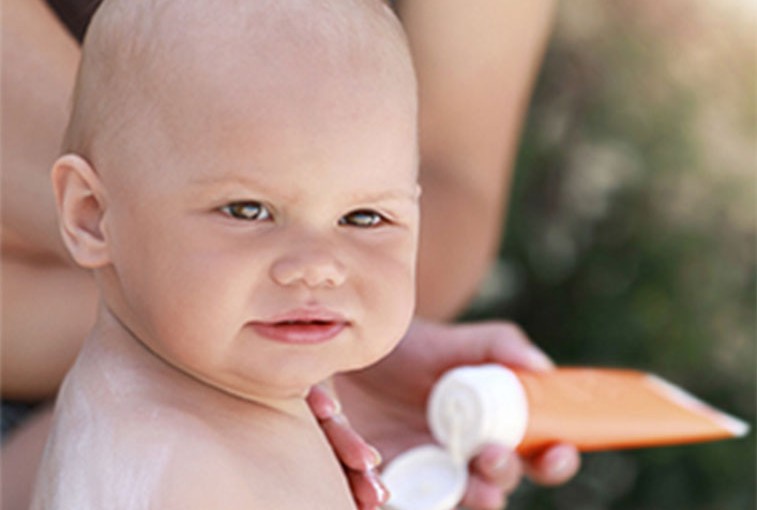Going for a walk, playtime at the park or a dip in the pool are all outdoor things that are fun to do with your little one. But when you take your baby out in the daytime, you have to take certain precautions to keep his or her sensitive skin safe. Use these items to cover and protect baby:
- A hat
- Tightly woven clothing with long sleeves and pants
- Sunglasses with ultraviolet (UV) protection
- A broad-spectrum sunscreen (that guards against UVA and UVB rays) with a sun protection factor (SPF) of at least 15
Sunscreens are recommended for everyone over 6 months of age. For babies younger than 6 months, the American Academy of Pediatrics recommends the use of sunscreen only if adequate clothing and shade are not available, and sunscreen should be washed off after going inside. Parents should still try to avoid sun exposure and dress the infant in lightweight clothing that covers most surface areas of skin. However, parents also may apply a minimal amount of sunscreen to exposed areas, such as the infant’s face and back of the hands. Rub it in well. Sunscreen sticks or blocks with titanium dioxide or zinc oxide are good choices and may be gentler on skin. Reapply it every 2 hours or after your baby sweats or gets wet. You can use it all over an older baby’s body, but be careful around the eyes. Also, try not to stay inside between the hours of 10 a.m. and 4 p.m., when the sun is strongest.
How to select a sunscreen
A sunscreen protects from sunburn and minimizes suntan by reflecting UV rays. Selecting a good sunscreen is important in protecting the skin. The American Academy of Dermatology (AAD) recommends choosing a sunscreen that offers:
- Broad-spectrum protection (protects against both UVA and UVB rays)
- An SPF of 30 or higher
- Water resistance (meaning the sunscreen provides protection while swimming or sweating for a time — either 40 or 80 minutes, depending on the label)
According to the AAD, the best type of sunscreen is any one you will use again and again. Provided that it meets the criteria above, the type you use is a matter of personal choice. Available options include:
- Lotions
- Creams
- Gels
- Ointments
- Wax sticks
- Sprays
How to apply sunscreen
Even when they use sunscreen, most people do not apply enough of it or apply it properly, which limits how useful it is. The AAD recommends the following guidelines:
- Apply sunscreen to all areas of skin that will not be covered by clothing.
- Use at least an ounce of sunscreen to cover exposed areas. You might need to adjust the amount depending on your body size.
- Apply the sunscreen to dry skin about 15 minutes before going outdoors to give it time to be absorbed.
- Reapply sunscreen at least every 2 hours, or more often after swimming or sweating.
- Protect your lips by applying a lip balm or lipstick that contains sunscreen with an SPF of 30 or higher.
Don’t rely on sunscreen alone
Using sunscreen when you are going out in the sun is important, but it is only one part of an overall strategy of protecting your skin from harmful UV rays. Other important strategies to protect your skin include:
- Seek shade when appropriate
- Limit your sun exposure between 10 a.m. and 4 p.m., when UV rays are the strongest
- Wear a hat with a wide brim and tightly woven clothing that covers most of your skin, as well as sunglasses
Remember that many over-the-counter and prescription medicines increase the skin’s sensitivity to UV rays. As a result, people can develop a severe sunburn in just minutes when taking certain medicines. Read medicine labels carefully and use extra sunscreen as needed. And be sure to check your skin for anything changing, growing, or bleeding. If you notice anything, see a doctor right away.
…
Posted In Children's, Dermatology, Health Information, Healthy Living, Women's
